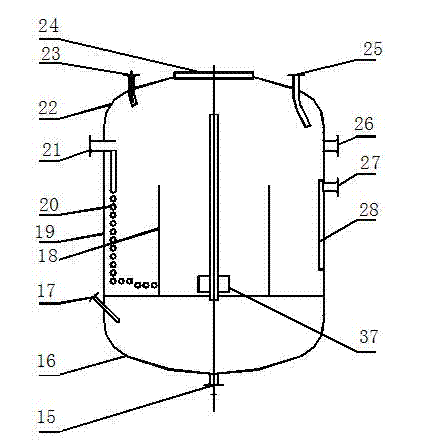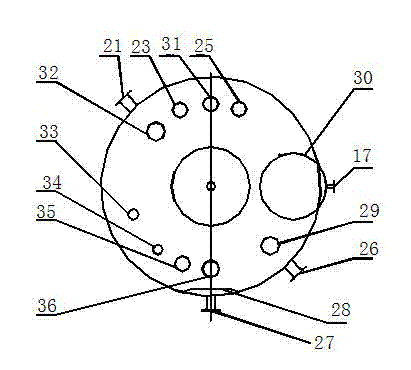Method and device for co-production of o-phenylenediamine and p-phenylenediamine
A technology for p-phenylenediamine and o-phenylenediamine, which is applied in the field of co-production of o-phenylenediamine and p-phenylenediamine, can solve problems such as potential safety hazards, and achieve the effects of large equipment operation flexibility, easy operation and stable liquid level
- Summary
- Abstract
- Description
- Claims
- Application Information
AI Technical Summary
Problems solved by technology
Method used
Image
Examples
Embodiment 1
[0029] Embodiment 1: co-produce o-phenylenediamine and p-phenylenediamine according to the following steps:
[0030] (1) In the primary ammonolysis reactor 7 and the secondary ammonolysis reactor 8, first add water equivalent to 50% of the total volume of the reactor;
[0031] (2) Turn on the steam of the heat exchange coil and keep the reaction temperature at 100°C;
[0032] (3) At 100°C under agitation, continuously feed ammonia gas into the primary ammonolysis reactor 7 and the secondary ammonolysis reactor 8; And the pressure in the secondary ammonolysis reactor 8 remains on 3MPa;
[0033] (4) When the pressure in the kettle reaches 3MPa, continuously add water and mixed nitrochlorobenzene into the primary ammonolysis reactor 7, and the speed of adding water is based on the fact that the residence time of water passing through the primary ammonolysis reactor 7 is 15.5 , the volume ratio of mixed nitrochlorobenzene and water feed is 0.2:1;
[0034] (5) While implementi...
Embodiment 2
[0045] Embodiment 2: co-produce o-phenylenediamine and p-phenylenediamine according to the following steps:
[0046] (1) In the primary ammonolysis reactor 7 and the secondary ammonolysis reactor 8, first add water equivalent to 60% of the total volume of the reactor;
[0047] (2) Turn on the steam of the heat exchange coil of the ammonolysis reactor and keep the reaction temperature at 130°C;
[0048] (3) At 130°C under stirring, continuously feed ammonia gas into the primary ammonolysis reactor 7 and the secondary ammonolysis reactor 8; And the pressure in the secondary ammonolysis reactor 8 remains on 4MPa;
[0049] (4) When the pressure in the kettle reaches 4MPa, continuously add water and mixed nitrochlorobenzene into the first-level ammonolysis reaction kettle 7, and the speed of adding water is based on the fact that the residence time of water passing through the first-level ammonolysis reaction kettle 7 is 10 , the volume ratio of mixed nitrochlorobenzene and wat...
Embodiment 3
[0061] Embodiment 3: co-produce o-phenylenediamine and p-phenylenediamine according to the following steps:
[0062] (1) In the primary ammonolysis reactor 7 and the secondary ammonolysis reactor 8, first add water equivalent to 70% of the total volume of the reactor;
[0063] (2) Turn on the steam of the heat exchange coil of the ammonolysis reactor and keep the reaction temperature at 160°C;
[0064] (3) At 160°C under stirring, continuously feed ammonia gas into the primary ammonolysis reactor 7 and the secondary ammonolysis reactor 8; And the pressure in the secondary ammonolysis reactor 8 remains on 5MPa;
[0065] (4) When the pressure in the kettle reaches 5 MPa, continuously add water and mixed nitrochlorobenzene into the primary ammonolysis reactor 7, and the speed of adding water is based on the fact that the residence time of water passing through the primary ammonolysis reactor 7 is 15.5 , the volume ratio of mixed nitrochlorobenzene and water feed is 1:1;
[0...
PUM
 Login to View More
Login to View More Abstract
Description
Claims
Application Information
 Login to View More
Login to View More - R&D
- Intellectual Property
- Life Sciences
- Materials
- Tech Scout
- Unparalleled Data Quality
- Higher Quality Content
- 60% Fewer Hallucinations
Browse by: Latest US Patents, China's latest patents, Technical Efficacy Thesaurus, Application Domain, Technology Topic, Popular Technical Reports.
© 2025 PatSnap. All rights reserved.Legal|Privacy policy|Modern Slavery Act Transparency Statement|Sitemap|About US| Contact US: help@patsnap.com



